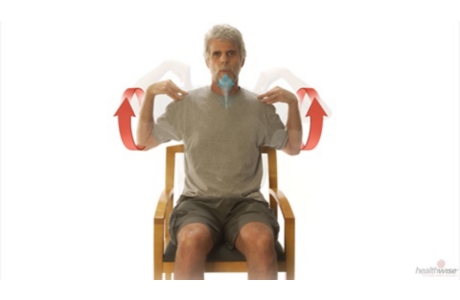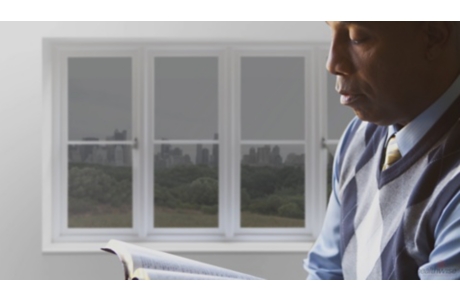Top of the pageActionset
COPD: Using Exercise to Feel Better
Overview
When you have COPD, activity and exercise can:
- Build muscle strength and endurance. This will help you be more active—you will be able to do more activities for longer amounts of time.
- Reduce shortness of breath.
Upper body exercises increase strength in arm and shoulder muscles, which provide support to the rib cage and can help improve breathing. They also help in daily tasks such as carrying groceries and doing housework.
Lower body exercises develop lower body muscles and will help you move around more easily for longer periods of time.
Aerobic exercise gets more oxygen to your muscles. This allows them to work longer.
Exercises for COPD can be done nearly anywhere. They are often done as part of a pulmonary rehabilitation program.
How do you exercise for COPD?
Exercises for COPD are simple to do and take little time.
If you become breathless while doing any of the exercises, rest in a position where your shoulders are supported, such as in a chair, and wait until you can breathe easily again.
- Talk to your doctor.
Your doctor may ask that you do specific exercises and will help you figure out how often and how long to do them. You may also get help with setting your long-term exercise program goals. It will take time before you are able to reach your goals. But how long it takes is not as important as doing the exercises consistently.
- Start slowly and gradually.
For each exercise, either time how long you can do it or count the number of times you can do it before you are mildly out of breath. Then rest and move on to the next exercise. Each week, increase the time you spend doing each exercise or how many times you do each one.
- Pick activities that you enjoy.
- Always have a warm-up and cool-down.
This is a good time for doing stretches.
- Pay attention to your breathing.
Try to breathe slowly to save your breath. Breathe in through your nose, keeping your mouth closed. This warms and moisturizes the air you breathe. Breathe out through pursed lips.
Aerobic exercise
Aerobic exercises increase the amount of oxygen that is delivered to your muscles. More oxygen helps the muscles work longer. This helps you do more activities for longer periods of time.
Any exercise that raises your heart rate and keeps it up for a long time will improve your aerobic fitness. These exercises include:
- Walking.
- Using a treadmill.
- Cycling or using a stationary bicycle.
- Swimming.
- Water aerobics.
Daily activities can also be aerobic. These activities include:
- Walking to work or to run errands.
- Sweeping (perhaps to fast-paced music).
- Playing actively with children.
- Walking your dog.
Talk to your doctor before starting a new exercise program. Your doctor will help you know how often and how long to exercise. You can also get help setting your long-term exercise goals.
Checking your exercise intensity
The talk test is an easy way to check your exercise intensity.
- You're getting moderate aerobic activity if you can talk but can't sing while you do the activity.
- You're getting vigorous aerobic activity if you can only say a few words while you do it.
- You are exercising too hard if you can't talk while you do it.
- You may not be exercising hard enough if you can sing while you do it.
How to do the exercises
Arm extension
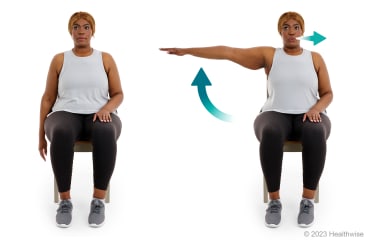
- Sit up straight with your feet slightly apart.
- Start with your arms by your side.
- Breathe out as you raise one arm to shoulder height, keeping the arm straight and pointing to the side.
- Breathe in as you return your arm to your side.
- Repeat with your other arm.
Elbow breathing
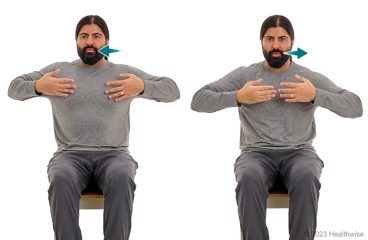
- Sit up straight with your feet slightly apart.
- Lift your elbows to shoulder level, and touch your fingertips together in front of your chest.
- Breathe in as you pull your elbows back so that your fingertips move apart.
- Breathe out as you return your elbows and fingertips to the starting position.
Elbow circles

- Sit up straight with your feet slightly apart.
- Put your right hand on your right shoulder and your left hand on your left shoulder. Your elbows should be at shoulder level and pointing out to the side.
- Slowly make a circle with your elbows.
- Breathe out as you start the circle, and breathe in as you complete the circle.
- Do some circles in each direction.
Knee extension

- Sit up straight with your feet slightly apart.
- Breathe out as you straighten one knee and raise your leg.
- Breathe in as you return your foot to the floor.
- Repeat with your other leg.
Leg lift
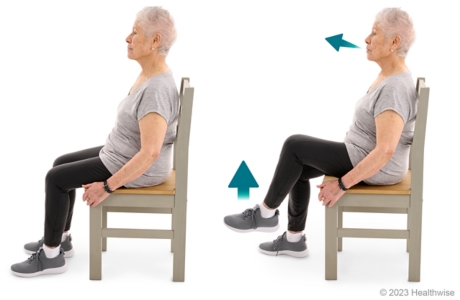
- Sit up straight with your feet slightly apart.
- Breathe out as you lift one leg straight up so that the knee rises toward your shoulder.
- Breathe in as you return your foot to the floor.
- Do the exercise with each leg. You can do a few with one leg and then switch legs. Or you can alternate legs like you're marching.
Step-up

- Stand on the floor, facing a bottom step. Hold on to the handrail. Or you can use a sturdy step stool placed next to a chair or counter. Hold on to the chair or counter.
- Breathe out as you take one step up.
- Then bring your other foot up.
- Breathe in as you step back down with one foot. Then bring your other foot down.
- If you can, try stepping up with your right foot sometimes and with your left foot at other times.
Credits
Current as of: August 6, 2023
Author: Healthwise Staff
Clinical Review Board
All Healthwise education is reviewed by a team that includes physicians, nurses, advanced practitioners, registered dieticians, and other healthcare professionals.
Current as of: August 6, 2023
Author: Healthwise Staff
Clinical Review Board
All Healthwise education is reviewed by a team that includes physicians, nurses, advanced practitioners, registered dieticians, and other healthcare professionals.
This information does not replace the advice of a doctor. Healthwise, Incorporated, disclaims any warranty or liability for your use of this information. Your use of this information means that you agree to the Terms of Use. Learn how we develop our content.

